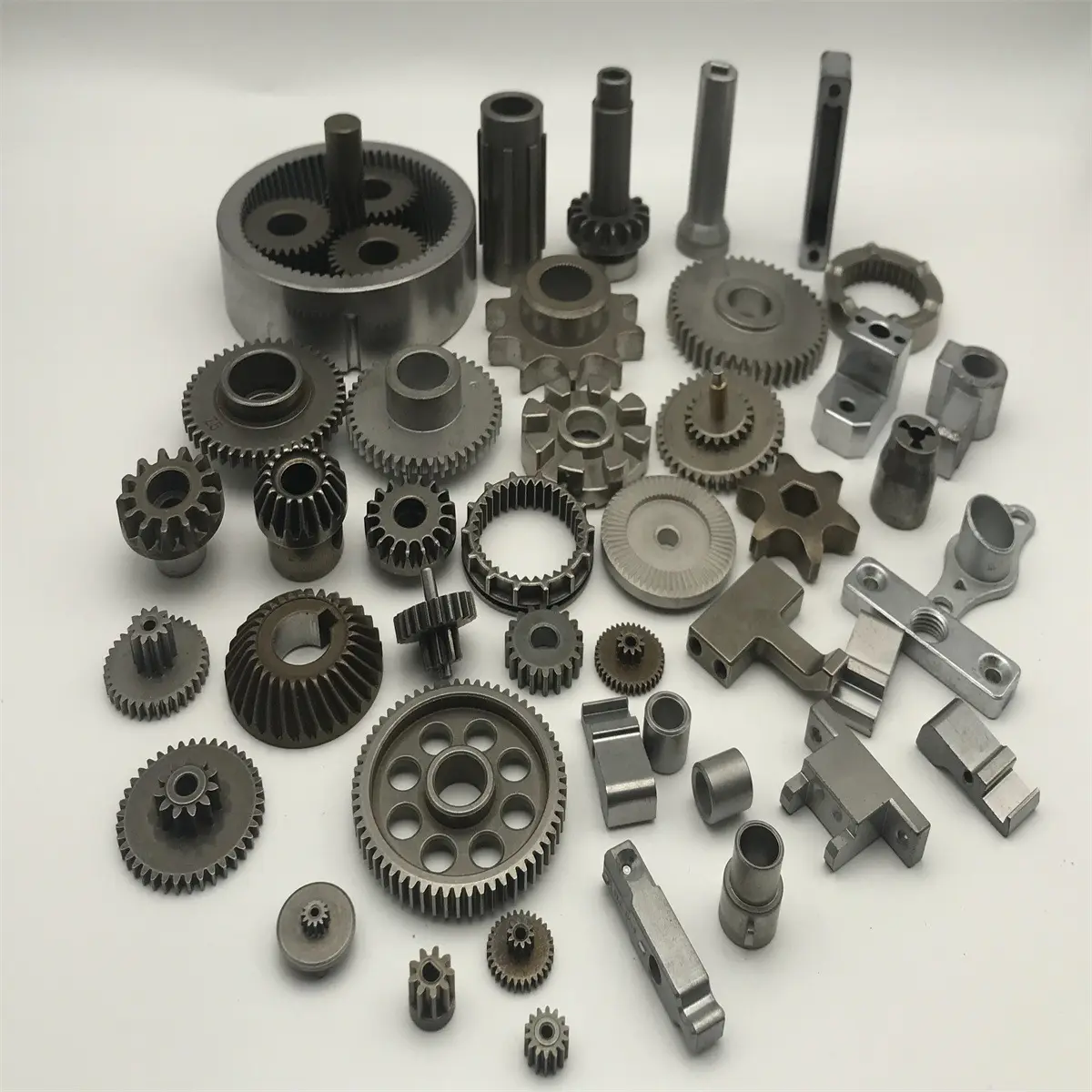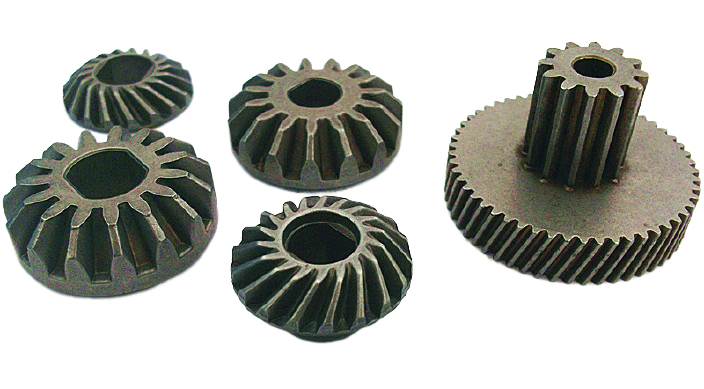Powder metallurgy gears are an important component of transmission components and the core component for transmitting power. So powder metallurgy gears must have characteristics such as high hardness, high strength, and high density. How to improve the hardness and strength of powder metallurgy gears through heat treatment is a necessary link in the production and processing of powder metallurgy gears.
BRM powder metallurgy gears, like other metal materials, can improve their mechanical properties through heat treatment. The heat treatment methods applied in BRM powder metallurgy gears include annealing, normalizing, quenching, tempering, as well as carburizing, nitriding, and carbonitriding. These methods can undoubtedly greatly improve the mechanical properties of powder metallurgy gears. However, due to the unique nature of powder metallurgy gears, when selecting heat treatment methods and process conditions, it is not entirely based on dense materials. Reasonable adjustments must be made to suit the treatment of powder metallurgy gears, otherwise the effect of heat treatment will not be achieved, and even destructive results will be caused. The main material used to improve the performance of powder metallurgy gears through heat treatment is iron based alloys (sintered steel).

The following points should be noted in the heat treatment of powder metallurgy gear sintered steel:
The effect of voids on carbon content. Due to the presence of pores in sintered steel, oxidation and decarburization are prone to occur during the treatment process if treated using the same method as dense steel. So for sintered steel containing 6% pores, heat treatment should be carried out in a protective atmosphere or buried in solid fillers (such as decomposed ammonia, natural gas conversion gas, charcoal, cast iron chips, etc.). In addition, due to the presence of pores and uneven density, it is easy to cause quenching cracks and deformation.
The voids in sintered steel have a thermal insulation effect, so compared to dense steel, sintered steel has lower thermal conductivity and is difficult to dissipate heat, resulting in poor hardenability.
The effect of organizational uniformity on austenitization, and the organizational uniformity of sintered steel deteriorates due to factors such as uneven distribution of carbon. The temperature and time for austenite homogenization are much higher than those of dense steel, and under the same conditions, the time to achieve complete homogenization is 50% higher. If alloying elements are added to sintered steel, the homogenization temperature will be higher and the time will be longer.
Several commonly used heat treatment methods for BRM powder metallurgy gears:
Quenching refers to the heat treatment process that heats the sintered steel to the temperature above the critical point, and rapidly cools it to Martensite structure at a cooling rate greater than the critical cooling rate after holding. Quenching is the most commonly used heat treatment method for sintered steel. The Martensite structure obtained by quenching can improve the strength, hardness and wear resistance of sintered steel. The quenching principle and process of sintered steel are basically similar to that of dense steel. The difference is that the quenching process of sintered steel needs to be carried out in a neutral or carburizing atmosphere to prevent pore surface oxidation. Due to the pore characteristics of sintered steel, oil quenching is usually used, and its quenching process includes heating austenitization, quenching, and tempering.
Tempering is necessary after quenching. Tempering is a heat treatment process that heats quenched steel to a temperature above 780 ℃, and then cools it to room temperature in an appropriate manner after insulation. The purpose of tempering is twofold, one is to eliminate internal stress and reduce the brittleness of the material. Tempering can be further divided into low temperature tempering, medium temperature tempering, and high temperature tempering.
Annealing and normalizing are preparatory heat treatment processes applied in the production of sintered steel. The purpose of annealing and normalizing is to eliminate internal stress, adjust the microstructure of the material, thereby adjusting the mechanical and technological properties of the steel, and prepare the structure and properties for the next process. For example, annealing treatment is required before processing such as re pressing, shaping, and cutting. Annealed and normalized products can also be used as finished products for Machine element with low requirements.

Several Case-hardening treatments of BRM powder metallurgy gears.
High frequency quenching, powder metallurgy gear high-frequency quenching is a method of surface quenching of workpieces, which involves placing the workpiece in a coil and applying high-frequency current. Under the action of the alternating magnetic field generated by the high-frequency current, the surface of the workpiece will generate induced electromotive force and vortex current. Due to the Skin effect, the induced eddy current is mainly concentrated on the surface of the workpiece, resulting in high temperature on the surface. High frequency quenching is the use of this heating principle to quickly heat the surface of the workpiece to a high temperature, and then quench to obtain surface quenched structure. A considerable portion of powder metallurgy gears that require wear resistance use high-frequency quenching heat treatment. When using high-frequency quenching heat treatment for powder metallurgy gears, it is necessary to pay attention to the inherent density of the gears, which should reach 6.85g/cm3;, This will achieve the strength of the gear itself, generate stress between local heating and non heating, and prevent parts from cracking.
Carbonitriding, which involves simultaneously penetrating carbon and nitrogen on the surface of powder metallurgy gears, further improving the hardness and wear resistance of the part surface. The method of carbonitriding is to add ammonia during the carburizing process, so that nitrogen is also infiltrated when further into the carbon. The temperature of carbon nitrogen co carburization is lower than that of individual carburization (about 55 ℃ lower), and the time is also shorter. The density of carbonitriding parts should be maintained at 6.85g/cm3;, For copper infiltration and high density (7.2g/cm3;) It is very effective.
Gear surface nitriding refers to the process of nitrogen containing gas coming into contact with sintered steel, where nitrogen atoms diffuse to the surface of sintered steel and react with the alloy elements chromium, aluminum, molybdenum, nickel, and tungsten in the steel to form nitrides. The surface hardness of the parts is further improved through nitriding. Nitriding can be carried out separately or through carbon nitrogen co infiltration. The method of nitriding is to raise the gear to a temperature of 495-565 ℃, introduce ammonia gas, and dilute the surface of the parts with highly active nitrogen atoms decomposed from the ammonia gas. The biggest difficulty in nitriding powder metallurgy gears is also porosity. Excessive pores cannot form a nitrided layer, and the generation of nitrides inside the gears can make the parts brittle.
Carburization on the surface of powder metallurgy gears can further improve their surface hardness. Carburization is the use of gases, liquids, or solids containing carbon as carburizing agents to diffuse carbon atoms to the surface of parts and react with iron at high temperatures, forming more cementite Fe3C. The higher the amount of carburization, the more cementite is formed, and the depth and surface hardness of the carburized layer are also higher. The concern of carburization is the depth and hardness of the carburized layer. The depth of the carburized layer is generally between 0.5 and 2.5mm. The main problem with carburization of powder metallurgy gear parts is the hardness of the surface carburized layer. Due to the presence of pores in iron based powder parts, carbon atoms may diffuse into the interior of the parts through the pores, making it difficult to form a clear carburized layer. Moreover, excessive diffusion of carbon into the interior can increase the brittleness of the parts, making it impossible to fully utilize the characteristics of high surface hardness, internal strength, and toughness. So parts with high porosity are not suitable for carburization.
Carburization is generally carried out at temperatures above 740 ℃. The optimal carburizing temperature for iron based parts with a porosity less than 10% is 920-940 ℃. The lower the carburizing temperature, the smaller the bending deformation of the part. Therefore, in cases of high precision requirements, low-temperature carburization at 860 ℃ should be used. After carburizing treatment, quenching is generally required to obtain higher hardness Martensite structure on the surface. There are two ways to quench by carburizing. One is direct quenching, which means that oil quenching is carried out directly after cooling to 750-850 ℃. This method results in a coarser microstructure because the austenite grains have coarsened during carburization, resulting in a decrease in mechanical properties; Another method is to first cool the carburized gear and then use the quenching process of sintered steel for quenching. This method can overcome the determination of direct quenching and obtain powder metallurgy gears with better performance.
Contact: Cindy Wang
Phone: +86 19916725892
Tel: 0512-55128901
Email: [email protected]
Add: No.6 Huxiang Road, Kunshan development Zone, JiangsuShanghai Branch: No. 398 Guiyang Rd, Yangpu District, Shanghai, China